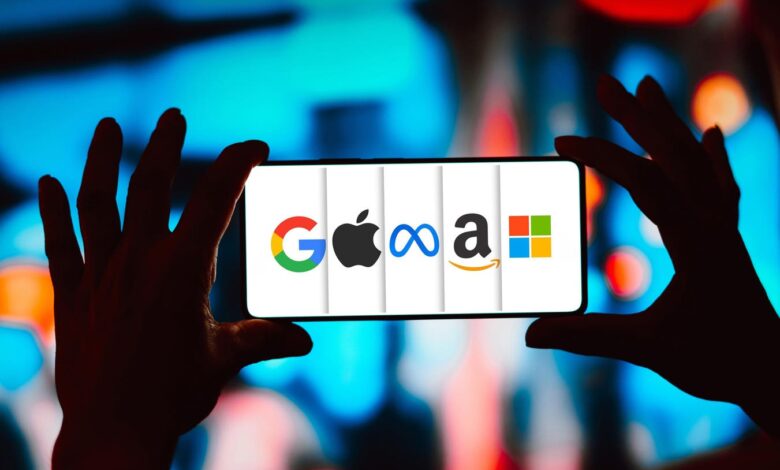Exploring Three Scenarios For How Gen AI Will Change Consumer Finance

Could consumer-facing tech behemoths (such as Alphabet, Apple or Meta) disintermediate financial … [+]
The rise of generative AI has led to much hand-wringing and discussion about the potential for the technology to disrupt industries and eliminate broad swathes of human jobs. But the impact of the technology will vary from industry to industry, so it’s important to look beyond the high-level talk around disruption and to think through exactly how it will change the financial services sector.
In the case of financial services, the impact of generative AI can be simplified into three possible future scenarios: 1) non-financial tech firms develop a dominant generative AI-based personal assistant and disintermediate financial firms, 2) no disintermediation, but the technology further entrenches the dominance of the largest global banks, and 3) no firms manage to establish dominant generative AI assistants, and the technology becomes commonplace without drastically altering market share.
While we can’t predict the future, it’s essential that financial services organizations think through the three possible outcomes to develop long-term plans for how their business would react to each of these scenarios.
Before diving into this topic, a caveat. The goal of this article is to to make the subject approachable for someone who is not familiar with the nuances of generative AI. This article will not discuss the technical developments that would drive these outcomes – e.g., whether it becomes cheaper and easier to build a proprietary large language model (LLM). This article will guide non-technical individuals through how generative AI will impact the financial services industry.
Scenario one: non-financial tech player(s) take a dominant position
One possible outcome for generative AI technology is that the consumer-facing tech behemoths (such as Alphabet, Apple or Meta) and/or a breakthrough tech startup develop consumers’ go-to personal assistant for a very wide range of life tasks, including personal finance. Consumer behavior changes, and the average person looks to the leading generative AI-based virtual assistant(s) with dominant market share to help them with questions and concerns.
This outcome sees generative AI technology evolve in such a way that tech firms are able to develop a superior personal assistant that is so advanced it incentivizes consumers to almost exclusively use their personal assistant. This assistant would monitor consumers’ affairs (via linked outside accounts) and would provide advice when asked questions like “how can I improve my financial situation?” or “could my savings be earning more?” This development would disintermediate financial services firms and the assistant would be able to influence consumers’ financial decisions and behaviors.
An advanced AI-based general personal assistant with dominant market share would disintermediate … [+]
If this scenario becomes reality, the response of financial services firms to this disintermediation partly depends on how regulation shakes out and whether AI assistants can earn referral fees. Beyond the referral question, in the long-term this outcome would likely make the financial services industry much more cutthroat.
In this scenario, financial services firms would need to become far more innovative and would need to develop compelling and unique products and services. Financial services firms would need to incentivize clients to actually log into their website and app and not just rely on their personal assistant. A generic product lineup and a generic client experience would gradually lose market share in a world driven by tech firms’ high-performing virtual assistants.
According to Remco Janssen, Founder and CEO of European tech news media company Silicon Canals, “in past tech hype cycles, the established tech giants were often slow to react. When it comes to generative AI technology, however, the largest firms have acted quickly. Tech behemoths like Apple, Google and Amazon
Amazon
Scenario two: the largest financial firms use gen AI to further entrench their dominance
In this scenario, generative AI technology develops in such a way that tech companies do not disintermediate financial services firms, but the costs and complexity of advanced AI technology allows the largest global banks to gain a competitive edge over relatively smaller rivals in the industry. For an example of the gulf between the top financial services firms and the next tier of financial institutions, as of May 10th, the market capitalization of JPMorgan Chase ($570.80 billion) and Bank of America ($300.69 billion) both exceed the combined market capitalization of US Bancorp, PNC, Capital One and Truist. The combined market capitalization of those four institutions is “only” approximately $235 billion.
The largest banks can dedicate far more resources generative AI. The CEOs of Wells Fargo, Bank of … [+]
It may turn out that the largest financial firms–those which can afford expensive engineering talent and cloud computing resources–can develop meaningfully more powerful generative AI-based financial assistants than the average financial services firm and the industry’s third-party vendors. If the largest global banks can offer a superior generative AI-based financial assistant, they will use this offering to further entrench their dominance of the industry and to win market share from relatively smaller firms.
Scenario three: no dominant gen AI assistants emerge
The final scenario sees generative AI technology become somewhat of a commodity and no firm develops a meaningfully superior generative AI assistant. Generative AI-based assistants become a standard feature of financial services websites and apps without fundamentally disrupting the industry and changing market share dynamics. Financial services firms may even end up relying on multiple third-party generative models simultaneously, calling upon different models depending on the user’s needs.
In this scenario, financial services firms would need to be thoughtful about how they optimize their generative AI assistant to minimize costs and maximize revenue. Financial services firms would work to continually improve their generative AI’s ability to handle customer service questions (preventing more expensive queries to the customer service call center) and to drive desirable actions (e.g., establishing direct deposit, opening a new account, etc.). While this third scenario presents less of a threat to the average financial services firm, developing a high-quality generative AI assistant still represents a large and complex undertaking.
If no dominant generative AI assistants emerge, firms would look outperform peers via superior user … [+]
According to Dr Andreas Rung, CEO and Founder of Ergomania, “banks and financial institutions have a tendency to keep big tech initiatives in the experimental/ideation phase for too long. Time is of the essence when it comes to generative AI. Your organization needs to move quickly to deploy a generative AI assistant to your customer base. In order to keep pace with the competition, your generative AI assistant must also become a seamless part of the UX and customer experience.”
Gen AI has the potential to upend financial services, and firms must start planning for future scenarios now
Only time will tell how generative AI technology develops and which of these three scenarios becomes reality. But your organization should start to think through these outcomes and how to react in each situation. Could your organization restructure and make a massive investment in developing a cutting-edge generative AI assistant if that becomes necessary? If your firm uses a third-party AI vendor, what are the “switching costs” if your firm “backs the wrong horse” and must make a change in order to keep pace with the leading firms? In each of these scenarios, how would your firm adjust the human workforce? It is better to start planning now than to be reactive and scrambling to catch up to changing market dynamics.
According to Milan De Reede, Founder and CEO of Nano GPT, “I see our customers’ preferences shift in real time as new generative AI models and updates are released. There’s no clear “winner” as of May 2024. Our customers seem to prefer different generative AI models for different tasks. At some point in the future, your firm may need to change your generative AI infrastructure and approach relatively quickly depending on which of these three scenarios becomes reality.”



